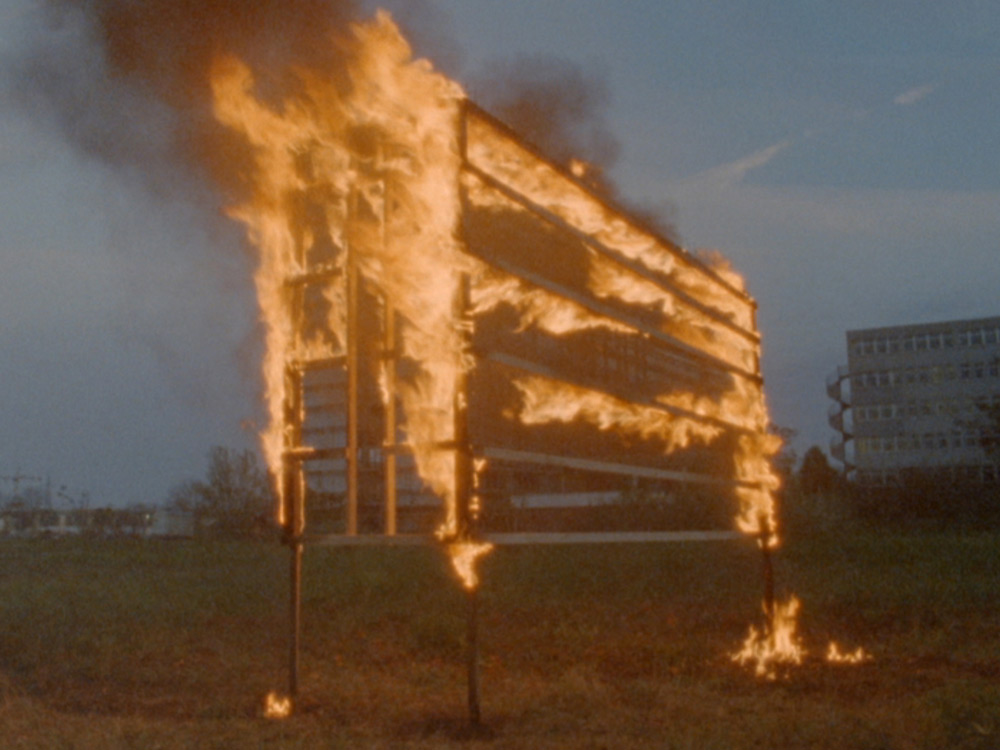Well that was a pretty great lecture. Speaking of running late, I ran so late to the David Benjamin Sherry – Elizabeth Siegel conversation moderated by Kevin Moore (I sort of wonder what that means – it almost sounds more like a debate—which of course I would have loved), that I got no more than the gist of it. The subject was landscape, more specifically western (U.S.) landscape; and our evolving views of and relationship to it, our treatment and overall perspective, as transformed by both technology and cultural attitudes. (I’m looking forward to actually seeing Sherry’s show of what appear to be chromogenic photographs at a gallery not far from Memorial Hall tomorrow.) In the meantime, I was introduced to an L.A. artist Elena Dorfman, who had also introduced her landscape (or landscape-derived) photography, to the FotoFocus audience. Dorfman shows at Modernism in San Francisco; and just from my first on-line glance at images, it looks fascinating on several levels. Sherry shows at OHWOW on La Cienega.
Jeff Rosenheim is not only a terrific curator (in addition to curating the major Met exhibition on Photography and the American Civil War, which was the basis of his lecture, he curated the Met’s Diane Arbus and Walker Evans exhibitions and probably a hundred other shows I’ve missed over the years), he’s also a dynamic speaker; and his lecture felt almost like a private walk-through of that Met show, giving the audience a sense of his own epiphanies and personal highlights in the show.
The title felt a bit ambiguous, although Rosenheim was clearly underscoring his fundamental point about the medium’s propaganda value in aggressively instituting the emancipation (and education) of the slaves (e.g., “I Sell the Shadow to Support the Substance”), as well as a few related ones. He made reference to both the mechanics and methodology of this very youthful imaging medium, its cultural role in these historic events, as well as issues of authorship and attribution. (As it turns out, Matthew Brady was an early ‘appropriation-ist,’ taking, or certainly co-opting into, credit for a great deal of photography by other less well known but important photographers (e.g., Timothy H. O’Sullivan and Alexander Gardner.) Rosenheim laid out his highlights and insights historically and almost procedurally. (E.g., the photography of the war’s carnage: photographers followed burial details onto the battlefield at day’s end; which documents in turn became important propaganda vehicles for (mostly) the North—which controlled so much of the technology.) The propaganda uses of photography were to some extent foreshadowed in Lincoln’s own presidential campaign, in which his portrait became a prototype campaign button (or as styled at that time, the campaign ‘medallion’).
War almost always brings serious technological change, which then spurs directly related and parallel cultural changes. One difference emphasized here is that photography was born alongside the American Civil War’s approaching hostilities and evolved, matured during its course. Rosenheim underscored the expanding role of photography in the “act of collective memory making” that would eventually become a part of the Civil War’s history. What I found most interesting, though, were the tectonic social and psychological as well as cultural shifts that accompanied this political/cultural/technological watershed: the individual (and by implication a society’s) relationship, not simply to “collective” memory, but to individuated memory, evidenced by concrete artifact; more importantly, the relationship to personal identity and its possession. (Its portability was yet another level of this possession and an agent of ‘collective memory’ making.)
In the U.S. Civil War, the portrait miniature goes mass market for the first time. The Civil War hand-colored tintypes and ambrotypes effectively become a kind of personal photo ID (soldiers commissioned and carried them on their persons) and family talisman for those who commissioned photographs of their young sons who were going off to be slaughtered or of themselves to be carried as keepsakes by the soldiers.
But this also extends to photographs more prominently exploited for propaganda purposes. Photographs of former, emancipated, or soon-to-be-emanicipated slaves both documented facts literally ‘written on the bodies’ of horrifically scarified and maimed bodies, but gave them faces, individuation, and legitimate identity—an implied if not explicit notion of equality.
It not only changed the American individual’s sense of personal identity and ownership of that identity (hence the free self), it also changed the individual’s regard for others’ perception of his/her identity. (Rosenheim used the example of Lincoln actually growing a beard, partially on the basis of a young girl’s impression of his formerly clean-shaven image.)
Not unlike his exhibition (and book) on the subject, Rosenheim covered a lot of ground (which will at some point be available on-line): the beginning of war photography, generally (photographers marched with the troops); a transformation of landscape photography (very much in the air this evening)—the documentation of ruins, systematic destruction, the recent fallen past in stark contrast with violent change; issues of photographic manipulation; and the unprecedented scale of military violence. The ‘blood on the leaves, blood on the root’ heart of darkness behind that nascent identity was not explored (beyond reference to the documentation of Sherman’s march); but then humanity remains remarkably resilient in setting aside social identity issues to create new killing fields.
I was less impressed with the Taiyo Onorato & Nico Krebs post-Conceptual creepily altered and manipulated landscape photographs at the Contemporary Art Center—pitched somewhere in affect between Alex Cox’s Repo Man, Stephen Shore road shows, Ridley Scott’s Thelma and Louise, way too many Conceptual and post-Conceptual photography shows, and bad episodes of the ancient television series, The Outer Limits. But Zaha Hadid’s architecture did not disappoint; and a couple of scotch and sodas managed to rinse off this bit of detritus before an excellent dinner hosted by the FotoFocus directors and principal fundraisers, elegantly (and conveniently) executed by the extraordinary staff of the 21c Hotel.


